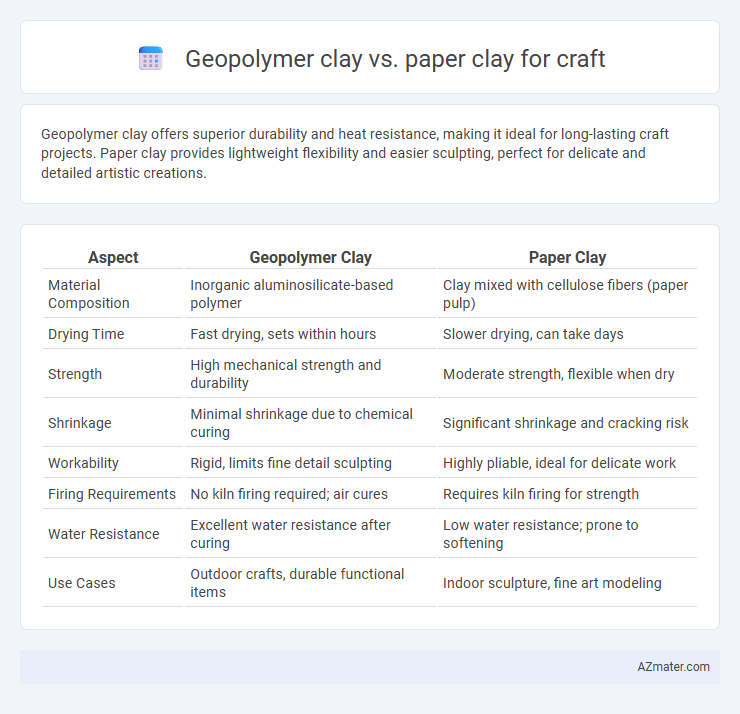Geopolymer clay offers superior durability and heat resistance, making it ideal for long-lasting craft projects. Paper clay provides lightweight flexibility and easier sculpting, perfect for delicate and detailed artistic creations.
Table of Comparison
| Aspect | Geopolymer Clay | Paper Clay |
|---|---|---|
| Material Composition | Inorganic aluminosilicate-based polymer | Clay mixed with cellulose fibers (paper pulp) |
| Drying Time | Fast drying, sets within hours | Slower drying, can take days |
| Strength | High mechanical strength and durability | Moderate strength, flexible when dry |
| Shrinkage | Minimal shrinkage due to chemical curing | Significant shrinkage and cracking risk |
| Workability | Rigid, limits fine detail sculpting | Highly pliable, ideal for delicate work |
| Firing Requirements | No kiln firing required; air cures | Requires kiln firing for strength |
| Water Resistance | Excellent water resistance after curing | Low water resistance; prone to softening |
| Use Cases | Outdoor crafts, durable functional items | Indoor sculpture, fine art modeling |
Introduction to Geopolymer Clay and Paper Clay
Geopolymer clay is an advanced, eco-friendly material composed mainly of aluminosilicate powders activated by alkaline solutions, offering high durability and heat resistance ideal for sculptural crafts. Paper clay integrates cellulose fibers into traditional clay, enhancing flexibility, reducing shrinkage, and allowing lightweight, fine-detail work with easy joining of dry pieces. Both materials provide distinct advantages for artisans: geopolymer clay excels in structural strength and longevity, while paper clay supports delicate, intricate designs with improved workability.
Composition and Material Sources
Geopolymer clay consists primarily of aluminosilicate materials derived from industrial byproducts like fly ash and metakaolin, combined with alkaline activators such as sodium hydroxide and sodium silicate, offering a durable and eco-friendly alternative. Paper clay combines traditional clay with cellulose fibers sourced from recycled paper, enhancing workability, drying flexibility, and reducing cracking during firing. Both materials leverage sustainable sources, with geopolymer clay utilizing inorganic industrial waste and paper clay incorporating organic recycled fibers for improved craft applications.
Environmental Impact and Sustainability
Geopolymer clay offers a sustainable alternative to traditional clays by utilizing industrial by-products like fly ash, reducing landfill waste and carbon emissions associated with ceramic production. Paper clay incorporates recycled cellulose fibers, enhancing strength and reducing raw material consumption while lowering energy needs during firing. Both materials promote eco-friendly crafting by minimizing environmental footprints compared to conventional clay, with geopolymer clay excelling in embodied energy savings and paper clay prioritizing renewable resource usage.
Workability and Ease of Use
Geopolymer clay offers excellent workability with its smooth, pliable texture that allows for detailed sculpting and fast setting, making it ideal for durable craft projects requiring minimal drying time. Paper clay, infused with cellulose fibers, enhances flexibility and lightweight handling, reducing cracking during drying and facilitating easy joining of pieces without slip. Both materials provide versatile options, but geopolymer clay excels in strength and quick curing, while paper clay is preferred for delicate works and ease of modification during the creative process.
Drying and Firing Requirements
Geopolymer clay requires low-temperature curing typically between 70-90degC, eliminating the need for traditional high-temperature kiln firing and reducing cracking risks due to minimal shrinkage. Paper clay, composed of traditional clay mixed with cellulose fibers, dries slowly at room temperature and must be fired in a kiln between 900degC and 1300degC to achieve durability and strength. The drying process for paper clay is more sensitive to environmental conditions to prevent warping, whereas geopolymer clay offers greater flexibility with drying and curing methods.
Strength and Durability of Finished Pieces
Geopolymer clay offers superior strength and durability compared to paper clay due to its chemical composition, which creates a dense, hard finish resistant to cracking and weathering. Paper clay, while lightweight and flexible during shaping, tends to be more fragile and prone to chipping or breakage once dried or fired. For artists prioritizing long-lasting, robust finished pieces, geopolymer clay provides enhanced structural integrity suitable for both indoor and outdoor crafts.
Surface Finish and Texture Possibilities
Geopolymer clay offers a smooth, stone-like surface finish with fine detail retention, ideal for sculptural and architectural crafts requiring durability and weather resistance. Paper clay provides a lightweight, porous texture that enhances surface variation and allows for easy blending and sculpting, making it perfect for delicate, textured finishes in fine art and mixed media projects. Both materials offer unique textural possibilities, with geopolymer clay excelling in solidity and paper clay in flexible, tactile surfaces.
Cost and Accessibility for Crafters
Geopolymer clay offers cost-effective durability with raw materials like fly ash and alkaline activators, making it a budget-friendly option for eco-conscious crafters. Paper clay, composed of clay mixed with cellulose fibers, tends to be more accessible via craft stores but can be pricier per unit due to its specialized formulation. Accessibility for beginners leans toward paper clay given its ease of use and availability, while geopolymer clay requires sourcing specific materials that may limit its immediate accessibility.
Common Craft Applications
Geopolymer clay and paper clay serve distinct roles in craft applications, with geopolymer clay excelling in durable, heat-resistant sculptures and functional items due to its inorganic, cement-like composition. Paper clay, enhanced with cellulose fibers, offers lightweight, flexible, and easy-to-sculpt properties ideal for delicate models, fine detailing, and mixed-media projects. Both materials accommodate diverse creative techniques but prioritize different strengths: long-lasting structural integrity for geopolymer clay and enhanced malleability plus drying adaptability for paper clay.
Choosing the Right Clay for Your Project
Geopolymer clay offers exceptional durability and water resistance, making it ideal for outdoor sculptures or functional pottery requiring strength and longevity. Paper clay is lightweight, flexible, and dries slower, perfect for intricate details and layered building in indoor craft projects. Selecting the right clay depends on your project's requirements for texture, drying time, and final use environment.

Infographic: Geopolymer clay vs Paper clay for Craft
 azmater.com
azmater.com